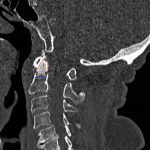Odontoid Fracture: Computed Tomography
History of present illness:
An 84-year-old male presented with left-sided posterior head, neck, and back pain after a ground level fall. Exam was notable for left parietal scalp laceration and midline cervical spine tenderness with no obvious deformities. He was neurovascularly intact, and placed in an Aspen Collar with strict spine precautions.
Significant findings:
Computed Tomography (CT) of the cervical spine showed a stable, acute, non-displaced fracture of the odontoid process extending into the body of C2, consistent with a Type III Odontoid Fracture. He was evaluated by orthopedic spine service who recommended conservative, non-operative management.
Discussion:
The cervical spine is composed of seven vertebrae, with C1 and C2 commonly referred to as the Atlas and Axis, respectively. Unique to C2 is a bony prominence, the Odontoid Process (Dens). Hyperextension or hyperflexion injuries can induce significant stress causing fractures. Odontoid fractures comprise approximately 10% of vertebral fractures, and there are three types with varying stability.1
Type 1 is the rarest and is a fracture involving the superior segment of the Dens. It is considered a stable fracture. Type 2 is the most common and is a fracture involving the base of the odontoid process, below the transverse component of the cruciform ligament. This fracture is unstable and requires operative stabilization.2 Type 3 odontoid fractures are classified by a fracture of the Odontoid process, as well as the lateral masses of the C2. Determining the stability of a Type III Odontoid fracture requires radiographic evaluation. Strict cervical spine precautions must be adhered to until adequate imaging and surgical consultation is obtained.
Computed tomography of the of cervical spine fractures poses several advantages to plain film radiography due to the ability to view the anatomy in three planes.3 However, if there is concern for ligamentous injury, MRI is the preferred modality.3
Topics:
Computed tomography, CT, cervical spine, cervical spine fracture, odontoid, orthopedics, spine, neurosurgery.
References:
- Koller H, Kolb K, Zenner J, Reynolds J, Dvorak M, Acosta F, et al. Study on accuracy and interobserver reliability of the assessment of odontoid fracture union using plain radiographs or CT scans. Eur Spine J. 2009;18(11):1659-1668. doi: 10.1007/s00586-009-1134-2
- Takai H, Konstantinidis L, Schmal H, Helwig P, Knöller S, Südkamp N, et al. Oblique axis body fracture: an unstable subtype of Anderson type III odontoid fractures-apropos of two Cases. Case Rep Orthop. 2016;7561682. doi: 10.1155/2016/7561682
- Jain N, Verma R, Garga UC, Baruah BP, Jain SK, Bhaskar SN. CT and MR imaging of odontoid abnormalities: a pictorial review. Indian J Radiol Imaging. 2016;26(1):108-119. doi: 10.4103/0971-3026.178358






